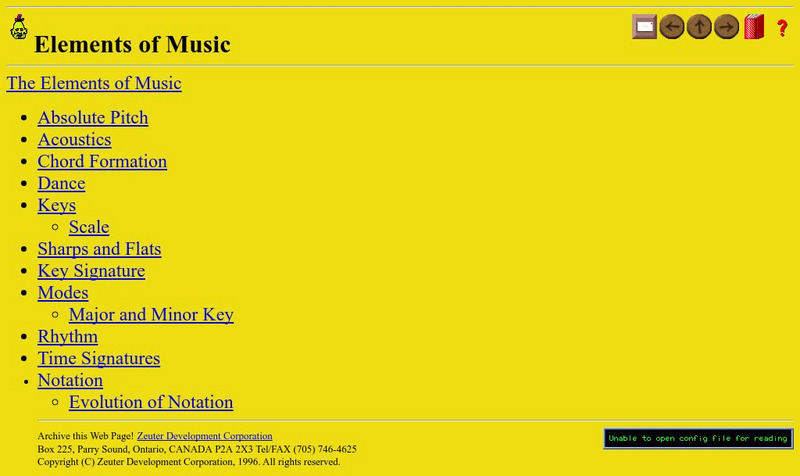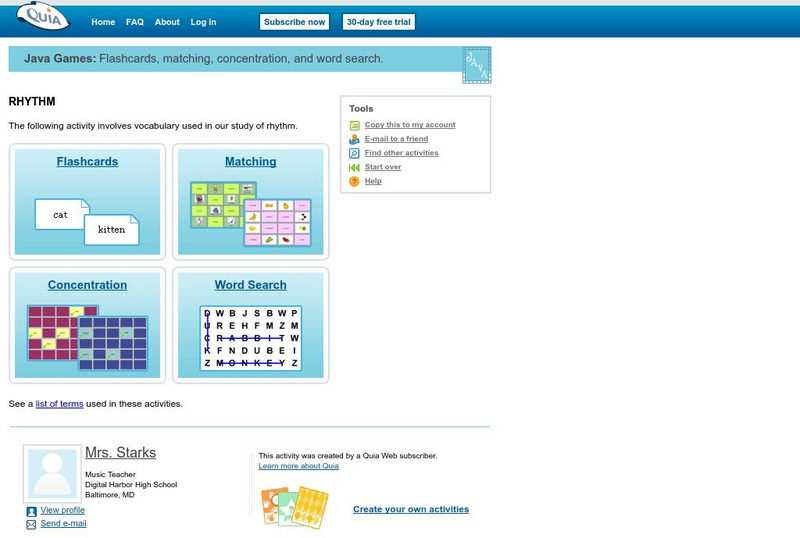Hi, what do you want to do?
Curated OER
A Round and A Round
Students practice singing rounds in daily warm-ups for 2 weeks prior to beginning this composition lesson. Students incorporate movement to the rhythm of each syllable, discuss syllables of words and their relationship to note values and...
Curated OER
Music and Technology
Third graders practice reading rhythm patterns with different types of notes and meters. Using a counting system, they perform a sight reading exercise and take notes when needed. They use a form of technology to illustrate the music.
Special needs in Music
Music Work Sheet (Special Ed)
Music is beneficial for all learners. Help your learners with special needs learn about different styles of music, as well as the ways that music is represented on paper, with 30 different worksheets.
Curated OER
All About Me
Learners examine who they are through the arts and sciences. They create a portfolio entitled, " All About Me."
Curated OER
Learning AB Form: Music
Third grade musicians play Orff instruments while they learn about the AB Form. First they learn part A of a song, then they listen to when the song changes. After they understand the concept of AB form, they learn to play part B. Note:...
Curated OER
Triple Meter
Students chant "Mabel, Mabel, Set the Table" in beats grouped in 4's using a percussive pattern. They repeat using 3's. Students sing a song in 4's and in 3's. they move to recorded music to practice threes. Students create Orff...
Curated OER
West Side Story
In this music worksheet, students examine the musical of West Side Story. They write parts of the musical while examining the musical score.
Curated OER
Spooky Notes
Second graders move to, sing, compose, and interpret various musical techniques through the use of "America", Tchaikovsky's "Waltz of the Flowers", and a song called "Skin and Bones". Emphasis is placed upon identifying names and values...
Curated OER
Twelve-Bar Blues
High schoolers examine blues music. In this music genres lesson, students discover details about the history of the musical genre and compositional techniques. High schoolers then compose melodies of their own with 12-bar blues chord...
Curated OER
Classroom Builder
Students explore music theory by discussing a classic song. In this musical notation instructional activity, students listen to the song "My Favorite Things" and discuss and share their personal tastes with the class. Students practice...
Curated OER
"Evening Bells"
Fourth graders sing "Evening Bells" while the repeat sign and double bar in the music notation. They listen and dance to a Viennese waltz. They locate the Danube River.
Curated OER
One Song, Many Voices
Students discuss the purpose and meaning of the song "One Song, Many Voices" and how the music expresses the composer's message. Students sing, conduct, and analyze two different songs during the lesson in a choir setting. This lesson is...
Other
Using Different Time Signatures to Create Interest
When composing, it can help to add interest to your music by using time signature changes. This article touches on how to use different time signatures to give the music a little push in a new direction.
Other
Alien Travel Guide: Elements of Music the Basics
Fine site created for Canadian schools devoted to basic elements of music, including pitch, acoustics, time signatures, keys, and rhythm.
Quia
Quia: Rhythm
Try these review activities in your music class! Chose from four games: matching, concentration, flashcards, or a word search. Vocabulary words on the topic of musical rhythm are used in these exercises.
Open Curriculum
Open Curriculum: Rhythm
To gain an understanding on durations, time signatures, tempo, and the basic elements of rhythm
Other
Music Theory First Aid for Struggling Students
This site provides music theory information on such topics as rhythm, intervals, scales, chords, etc. Also, there is a fine section which describes the basic concepts of form and structure.
ClassFlow
Class Flow: Virtual Rhythm Blocks
[Free Registration/Login Required] Virtual rhythm blocks represent various rhythms visually. Blocks can be moved and arranged to compose rhythms in various time signatures. Blocks contain Gordon rhythm solfege (du, du-de)
BBC
Bbc: Music Theory
This resource presents a fun and interactive way to learn all about the elements of music. It offers links to information, definitions, assessments, and examples of melody, harmony and tonality, structure, tempo, metre and rhythm,...
Music Theory
Music theory.net
An online beginning music theory and ear training site. This site is for students to use at home to reinforce what they learn in class.
Other
The Basics of Reading Music
This site is an overview of how to read music. The basics of notation such as note and rest values, the names of lines and spaces of both treble and bass clefs, etc. are covered. Includes downloadable audio files.

























